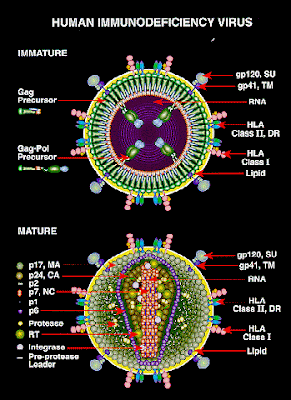The provision of breastfeeding
Mother who decided to breastfeed their children must be wary that:
• Therapy profilaksi antiretrovirus given during childbirth and the baby immediately after birth, will not provide protection for a longer breast fed infants.
• More than 20% of breast fed infants of HIV positive mothers are likely to get HIV infection through breastfeeding.
1. Giving breast milk exclusive
Advantages:
- Breastfed babies easily digested and provide all the nutrition and fluids is required. Baby will not need food or other beverages during the first 6 months.
- Breastmilk is always available and does not require special preparation to provide them.
- Breastfeeding can protect babies from diseases, especially diarrhea and pneumonia.
- With breastfeeding will create inner bond between mother and baby to be more closely linked.
- Compared to the combination of milk, breast-feed exclusively on the first few months can reduce the risk of HIV transmission.
Losses:
- Risk of transmission of HIV from mother to baby during the baby's remains are still breast fed by HIV positive mothers.
- Risk of transmission of HIV to be greater when there is a breast infection such as mastitis, or abrasions, and bloody hilt.
- For mothers who work, difficult for him to provide appropriate breastfeeding baby needs (baby breastfeed at least 8-10 times a day), unless the mother have a place to store ASI (for example, in the refrigerator).
- Mother who breastfeed need extra nutrition as an additional 500-750 kcal / day to assist mothers in breastfeeding the baby exclusively for 6 months first.
2. Giving breast milk with period stop breastfeeding
Mother with HIV who choose to breastfeed the baby must stop immediately after the breastfeed available for breastfeeding. Before entering the stop breastfeeding , a few days to two weeks, the mother with HIV should get information on how to maintain breast health, psychosocial support, and additional nutrition for the baby.
Advantages:
- The period of breastfeeding stop decided early exposure of HIV through breastfeeding.
Losses:
- Baby nutrition become less after breastfeeding stops if milk of an appropriate breastmilk is not available or not provided, as appropriate.
- Babies are at risk for becoming infected diarrhea when breastfeeding is not a substitute for milk prepared correctly.
- Baby became restless and would not even be drinking if stop breastfeeding done too quickly.
- breast mother can become hot during the stop breastfeeding if breastfeeding is not removed and discarded.
- Mother's pregnancy at risk for more sexual activity, if conducted.
- Early stop breastfeeding not recommended for infants have been known to be infected with HIV.
3. ASI Trought mother giving milk
Advantages:
- The use of maternal milk does not make the existence of HIV in the baby if the mother's milk is not infected with HIV.
- Some of the benefits of breastfeeding is also valid if the breastfeeding mother with the milk.
Losses:
- Mother's milk should test first and not infected with HIV.
- Mother's milk must protect themselves from the risk of HIV transmission during breastfeeding.
- Mother's milk should always be ready to breastfeed the baby as often as possible both day and night, or he must save the milk dikefor granted when he was far from a baby.
- In certain circumstances, will raises the question of the family or community about the situation his mother and the mother have a tendency to get pregnant again when doing sexual activities.
4. Giving breast milk with heat Flash
According to Morris, 2007, with the spark that breastfeeding has an important role in the transition from exclusive breastfeeding to solid feeding. And from research conducted by Dr. Israel-Ballard in California, United States, the results obtained with the spark that breastfeeding can inactive HIV in the breastmilk of mothers infected with HIV-positive.
Protocol in the heat breastmilk in the study can be adjusted to your own home. Air susu placed in sterile container that is not closed in a large pot containing 450 ml of water. Water is heated to boiling and then immediately cooled to a temperature 37C. (Morris, 2007)
Advantages:
- The HIV virus into the warm water inactive milk.
- Breast milk is the perfect food for babies, and most nutrient are still in it after heat.
- Breastmilk is always available for babies.
- Other family members can assist in providing food for babies.
Losses:
- While the ASI heat"does not" contain HIV, milk water is not as effective as usual breastmilk protects the baby in a variety of other diseases, but still better when compared milk formula.
- Rack and heat ASI requires time and often must be done.
- ASI must be cooled before and given out within 1 hour after heat.
Education and Monitoring
Every baby born from mothers with HIV-positive should have to be guarded the confidentiality of the mother and her family, and the need for the provision of counseling on the family. In care with no difference in caring for babies in general, just need special attention on the prevention of the occurrence will risk of infection. (Pusponegoro, 2004)
In the provision of routine immunization, according to Pusponegoro, 2004, remain to be done according to the schedule that has been recommended. Effectiveness and effects caused by the provision of immunization to this many are reported. (Pusponegoro, 2004)
In the HIV infection, the baby can experience weight infants with mild or fail to grow. Therefore, the baby needs to grow flowers, followed by a monitoring body weight, head circumference, and length of the body. Mothers should also always carry the baby for further examination: (Pusponegoro, 2004)
- Hits back to the monitoring body weight.
- Counseling on the provision of nutrition at the baby.
- The supervision will be the emergence of signs on the alert that includes the baby to drink less than 6 times a day or drink only a little, diarrhea, weight loss is difficult to ride.
In addition, the therapy can anti retrovirus that can affect the prognosis previous baby to grow and develop further. In the baby had got anti retrovirus therapy when the mother must have check-up. The examination carried out until 6 years to ensure that development in children does not show deviation in development, immune system disruption, brain development, and no tumor growth. (Mofenson, 2007)
Abdominal Pain
16 years ago



























